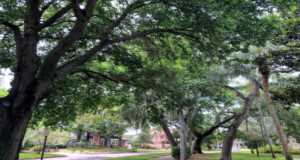This new 13-page article combines canopy coverage data from all of Florida’s metropolitan and micropolitan areas with ecological models developed by the USDA Forest Service to calculate several key benefits of urban trees and an approximation of their monetary value. Benefits of urban trees include carbon sequestration/storage, air pollution filtration, and stormwater mitigation. Written by Drew C. McLean, Andrew K. Koeser, Deborah R. Hilbert, Shawn Landry, Amr Abd-Elrahman, Katie Britt, Mary Lusk, Michael G. Andreu, and Robert J. Northrop, and published by the UF/IFAS Environmental Horticulture Department.
https://edis.ifas.ufl.edu/ep595
Tag: Urban Landscapes
How Much Space Does My Shade Tree Need? Planting Space Recommendations for Medium and Large Trees in Florida Cities
Trees provide urban landscapes with shade, beauty, and habitat. They can also help lessen the effects of flooding and urban heat buildup while storing carbon dioxide, a major greenhouse gas. When planted in the wrong place, however, trees can damage urban infrastructure. To maximize the benefits provided by urban trees, we need better-informed tree selection and larger planting spaces with the capacity to support big-canopy trees. This new 8-page fact sheet is intended to help arborists, urban foresters, landscape designers, landscapers, and anyone else responsible for the planting of trees in developed areas make informed decisions regarding the planting width requirements of the trees they select. Written by Deborah R. Hilbert, Andrew K. Koeser, Brooke L. Moffis, JuWanda G. Rowell, and Drew C. McLean, and published by the UF/IFAS Environmental Horticulture Department.
https://edis.ifas.ufl.edu/ep592
How to Properly Dispose of Unwanted Medications
Properly disposing of expired or unused medications can help reduce the prevalence of prescription drug abuse in Florida. It also helps prevent accidental ingestion by children or pets, helps prevent accidentally taking the wrong medication, and prevents medications from entering water sources. This new 3-page publication of the UF/IFAS Department of Soil and Water Sciences provides some dos and don’ts for disposing of your medications. Written by Alexander J. Reisinger.
https://edis.ifas.ufl.edu/ss680
How to Establish an Urban Agriculture Ordinance
While the desire to implement urban agriculture projects is growing in popularity, there is little information available to help Extension agents and interested citizens fully understand how to implement urban agriculture in their community. This new 11-page document provides an overview of key information required to establish an urban agriculture ordinance. Case studies from urban agriculture initiatives in Florida provide real-world examples of the required activities, potential challenges, and beneficial partners for implementing these initiatives. Resources related to the case studies and additional urban agriculture resources can be found at the end of the document, so that readers can find further information specific to their interests and needs. Written by Candace A. Spencer, Catherine G. Campbell, Anna Prizzia, and Liz Felter, and published by the UF/IFAS Horticultural Sciences Department.
http://edis.ifas.ufl.edu/hs1327
Ten Strategies for Working With Your Home Owner Association to Convert to a Florida-Friendly Yard
 Many homeowners are beginning to rethink their landscapes for several reasons, including mandated water and fertilizer restrictions, increasing maintenance costs, and concern for the environment. But over sixty million people now live in neighborhoods governed by Homeowner Associations, whose regulations can make it difficult to implement some changes by mandating types of plants, percentages of turf and plant material, location of plant materials, and restricting specialty gardens to back yards. More environmentally sound landscapes are possible with careful planning and design and by using an educated and knowledgeable approach to working with the HOA board to gain approval for a new landscape. This 9-page fact sheet offers several strategies for working within HOA regulations to gain approval for a Florida-Friendly landscape. Written by Gail Hansen and Claire Lewis, and published by the UF Department of Environmental Horticulture, February 2015. (Photo credit: Florida-Friendly Landscaping™ Program)
Many homeowners are beginning to rethink their landscapes for several reasons, including mandated water and fertilizer restrictions, increasing maintenance costs, and concern for the environment. But over sixty million people now live in neighborhoods governed by Homeowner Associations, whose regulations can make it difficult to implement some changes by mandating types of plants, percentages of turf and plant material, location of plant materials, and restricting specialty gardens to back yards. More environmentally sound landscapes are possible with careful planning and design and by using an educated and knowledgeable approach to working with the HOA board to gain approval for a new landscape. This 9-page fact sheet offers several strategies for working within HOA regulations to gain approval for a Florida-Friendly landscape. Written by Gail Hansen and Claire Lewis, and published by the UF Department of Environmental Horticulture, February 2015. (Photo credit: Florida-Friendly Landscaping™ Program)
http://edis.ifas.ufl.edu/ep513
FOR271/FR333 Florida’s Urban Soils: Underfoot Yet Overlooked
FOR271, a 6-page illustrated fact sheet by Donald Hagan, Cynnamon Dobbs, and Francisco Escobedo, provides an overview of Florida’s urban soils emphasizing their ecosystem services and sustainable management. Includes references and glossary. Published by the UF School of Forest Resources and Conservation, July 2010.
http://edis.ifas.ufl.edu/fr333


